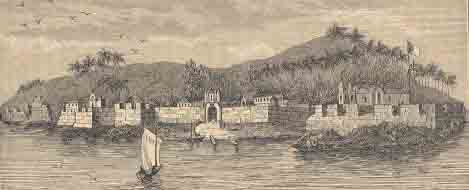Anjediva Fort

Information on Anjediva Fort (Goa) - History & Architecture
Anjediva Fort is one of the popular forts of Goa. It is situated in Anjadip Island whichis located in the boundary of Goa. This fort is also known as Anjadiva Fort or Anjediva Fort which was created by Portuguese rulers during the year 1505 AD. Once ruled by Portuguese people, Anjediva Fort has presently become a ruined construction.
Anjediva Fort Architecture
Anjediva Fort was initially developed for enhancing the military power as well as for overseeing the naval trade and business. The fort is small in size and the architecture exposed by excavations demonstrate that Anjediva Fort has large pillars along with various stone works and pots. The architecture of Anjediva Fort is based on the work of Kadambas and Chalukyas dynasty who ruled during the period of 11th and 12th century respectively. Anjediva Fort houses a church namely, 'Church of Our Lady of Springs' which was supposed be the temple of Aryadurga in traditional times. However, in later days the temple was converted into a church. The fort and the church both were situated in Anjadip Island with an area of about 1.5 square kilometre.
Anjediva Fort History
The history of Goa, articulates about the ancient explanations which drove Portuguese rulers to create Anjediva Fort. In the year 1505, a Portuguese ruler, named Dom Francisco appeared in India and ordered to create four forts and one of them is Anjediva Fort. The fort was intended to act as vital hub for trade, mainly spices in several nations. In order to enhance the trade and to obtain better managerial control in Goa, a famous mariner Vasco da Gama along with a Jewish seller, Gaspar da Gama demanded the then Portuguese ruler to develop a maritime fort in the region of Anjediva. As a result, Dom Francisco initiated the construction of Anjediva Fort in 1505. The local people provided the requisite materials such as timber and bamboo among other stuffs in order to create the fort. It is said that the temple of Aryadurga which was situated in that area was used in order to gather stones for the construction of Anjediva Fort. It took approximately three months in order to create the fort.
Subsequent the creation of Anjediva Fort, it was engaged by Portuguese for military defences and also for regular naval stops for the ships and containers. The fort permitted Portuguese rulers to overthrow various strong foes. In the year 1506, one Portuguese ruler, Dom Francisco demolished the fort and its crumbling rooms are still viewable in present days. In 1682, another Portuguese ruler named Alvor had reconstructed Anjediva Fort with inhabitation of over 600 persons. Facilities such as school and college was also established in the fort. Nevertheless, Anjediva Fort was abandoned by Portuguese people during 1843. Afterwards, Hindu and Christians started to use the fort as accommodation. It was said that when Anjediva Fort was under the authority of Portuguese rulers, it was attacked by Mughal ruler, Tippu Sultan. In the year 1961, Anjediva Fort was legitimately acknowledged as a portion of India.
Anjediva Fort Tourism Importance
Presently, there is a marine base in Anjadip Island. This base has been quickly restructured to provide accommodations to western military group. Due to this reason, Anjediva Fort is not accessible straightforwardly by the common people. However, travellers can enjoy the scene of Anjediva Fort through various means. Still, due to existence of military group, this place has not been promoted significantly as a tourism place for general travellers.
- Andaman Nicobar Monuments
- Andhra Pradesh Monuments
- Assam Monuments
- Bihar Monuments
- Chhattisgarh Monuments
- New Delhi Monuments
- Goa Monuments
- Gujarat Monuments
- Haryana Monuments
- Himachal Pradesh Monuments
- Jammu and Kashmir Monuments
- Karnataka Monuments
- Kerala Monuments
- Madhya Pradesh Monuments
- Maharashtra Monuments
- Odisha Monuments
- Punjab Monuments
- Rajasthan Monuments
- Tamil Nadu Monuments
- Telangana Monuments
- Uttar Pradesh Monuments
- West Bengal Monuments